Day 3 of a three day long weekend of tours today, the final day. It was forecast to be rather overcast but surprisingly turned out to be a really glorious spring day, warm with lots of sunshine and light winds – a lovely day to be out birding.
Our first port of call was Holkham. There was lots of activity around the trees, with several Spoonbills flying round and landing in the tops and others flying off to feed. We got a couple in the scope and could see their yellow-tipped, spoon-shaped bills. There were also Grey Herons and Little Egrets coming and going, and we could see lots of Cormorants on their nests in the trees.
A female Marsh Harrier came up from the reeds and circled round in front of us, before perching in the top of a hawthorn. She was probably waiting for the male to return with food. Two Red Kites circled high over the grazing marshes, engaging in a spot of mock combat at one point, one diving down and the other jinking out of the way. A little later one of the Red Kites drifted overhead.
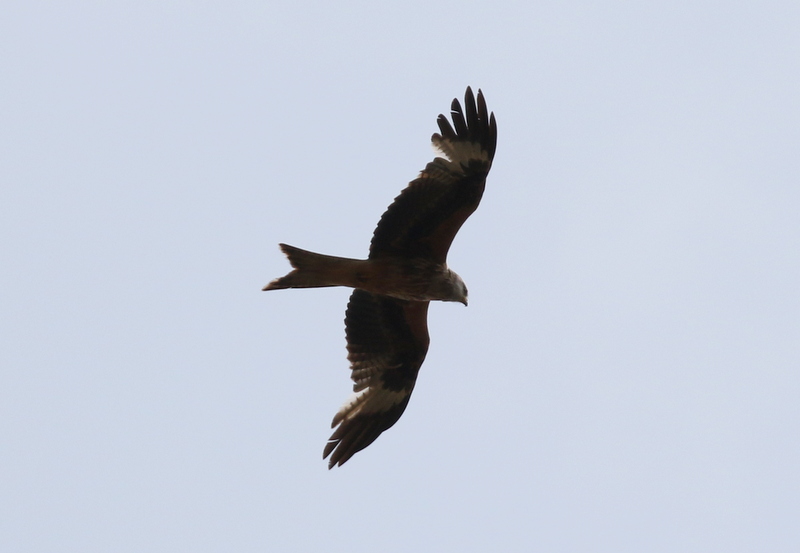 Red Kite – two circled over the grazing marshes
Red Kite – two circled over the grazing marshes
There are always lots of geese out on the grazing marshes at this time of year. Many of the Greylag Geese have goslings of various sizes and there are quite a few Canada and Egyptian Geese here too. Going through them carefully, we managed to find a couple of Pink-footed Geese, although rather distant. There are huge numbers of Pink-footed Geese here in the winter but the very small number which linger here all year are typically sick or injured birds.
Our next destination was Stiffkey Fen. As we pulled up, we could hear several Skylarks singing over the set-aside field opposite. As we walked down along the path, we could hear Chiffchaffs and Blackcaps singing from the hedges and trees. A couple of Common Whitethroats were delivering their scratchy song too, from the brambles. A Cetti’s Warbler shouted at us from the hedge. From the taller sallows we could hear a different song, like a Blackcap, but faster, more rolling, more sustained, a Garden Warbler.
There are also lots of insects out in the warm weather today. Along the path out to Stiffkey Fen, we found several Orange Tip butterflies. An Azure Damselfly rested on a nettle in the sunshine. But out at the seawall we found that all the vegetation along the bank, which had been full of insects in recent days, had been mown. Presumably the responsibility of the Environment Agency, they seem to have done a job lot of North Norfolk’s seawalls the last week or so and no one can quite understand why.
 Azure Damselfly – enjoying the sunshine at Stiffkey Fen
Azure Damselfly – enjoying the sunshine at Stiffkey Fen
From up on the seawall, we had a good view out across the Fen. Several pairs of Avocets here have chicks now, little bundles of fluff on legs! But there were comparatively few other waders on here today. Over on the saltmarsh, several Redshank were perched on prominent bushes and one even on the top of the mast of one of the boats. A Marsh Harrier circled up from the saltmarsh and drifted overhead.
 Marsh Harrier – this male circled overhead at Stiffkey Fen
Marsh Harrier – this male circled overhead at Stiffkey Fen
There were a few Brent Geese still out on the saltmarsh and even more out in the harbour. Many have already left, but presumably most of these should still soon be hurrying on their way to Russia to breed. The tide was just going out, but apart from lots of Oystercatchers, there were no other lingering waders out in the harbour today.
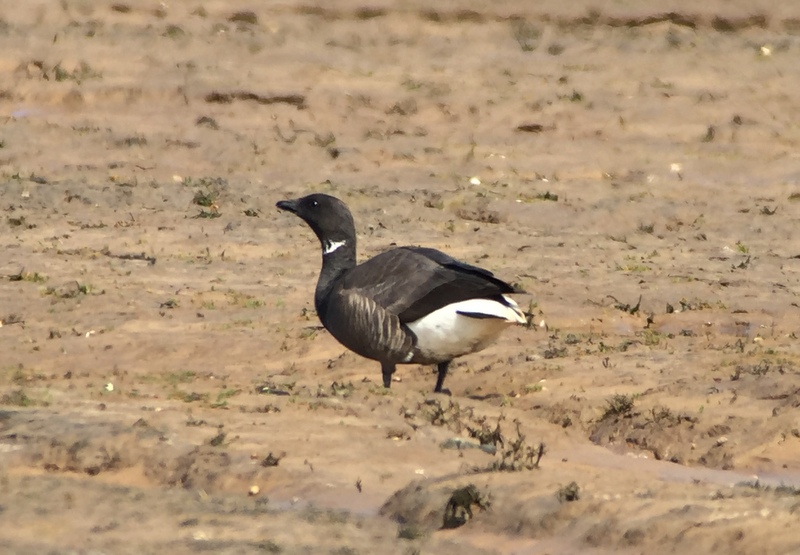 Brent Geese – still quite a few are lingering in the harbour
Brent Geese – still quite a few are lingering in the harbour
We could see quite a few terns out over the water, which on closer inspection turned out to be mostly Common Terns. A nice bonus was a single Arctic Tern in with them. It was rather distant, but its distinctive shape gave it away, the extra long tail and short head projection, as well as the silvery white primaries and different flight. Several groups of Little Terns were zooming about too, but there were comparatively few Sandwich Terns. Apparently, due to a large number of rats on Blakeney Point this year, many of the Sandwich Terns have moved over to Scolt Head to breed instead. Two distant Mediterranean Gulls flew west along the point and out over the harbour, flashing their pure white wingtips as they went.
On the walk back, a Little Ringed Plover flew past, displaying, and appeared to drop down onto the Fen, but there was no sign of it on there when we got back. As we got back to the car, a smart male Yellowhammer flew past and a Lesser Whitethroat was now singing from the hedge.
The reserve at Cley has been rather quiet in recent days, with lots of Avocets on Pat’s Pool but seemingly rather little else. We decided to walk out to the East Bank, as the wet grazing marshes there have been rather more productive. On the pools at the start of the East Bank a female Common Pochard was leading her nine ducklings around the reedy edges looking for food. A Little Grebe which surfaced nearby was promptly chased off across the pool.
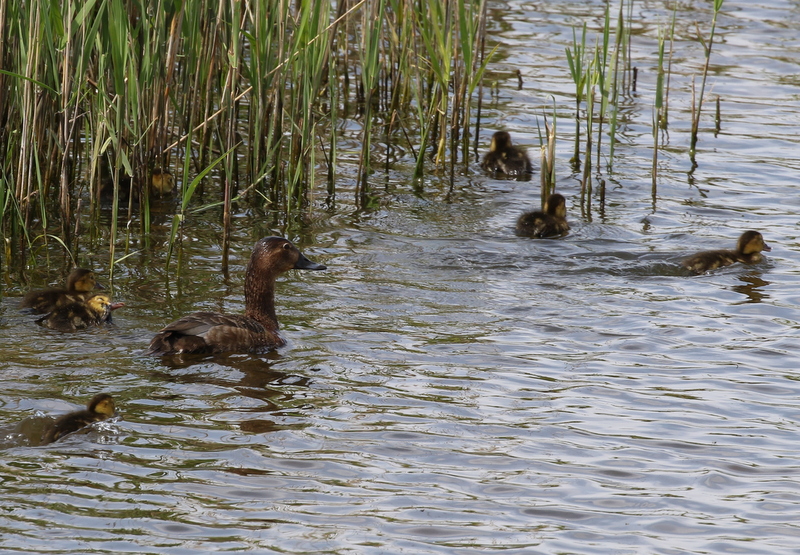 Common Pochard – this female was tending to her nine ducklings
Common Pochard – this female was tending to her nine ducklings
Out on the grazing marshes, we could see several Lapwing chicks of various sizes. It is always good to see youngsters of this sadly declining species. Looking out towards Pope’s Marsh we found a single Common Sandpiper and two Little Ringed Plovers, although rather distant.
We got great views of both Reed Warblers and Sedge Warblers as we walked out along path. A Sedge Warbler came up to feed on the alexanders by the path, which shows the value in not mowing the banks too early, and the Reed Warblers were feeding along the edge of the ditch below. A Sedge Warbler was singing and song flighting from the edge of the reeds and at one point we had Reed and Sedge Warbler singing either side of the path – a great opportunity to appreciate the differences in song between these two often confusing species. We heard a couple of Bearded Tits calling, but only managed to see one as it zoomed off over the reeds away from us.
There were not many waders on Arnold’s Marsh either today, apart from the local Avocets and Redshanks – there seems to have been a big clear out in the last few days. We did find three Ringed Plovers, a nice addition to the day’s tally. A smart male Reed Bunting was out on the saltmarsh just in front of the new shelter and their were several Meadow Pipits singing, fluttering up and parachuting back down to the ground as they did so.
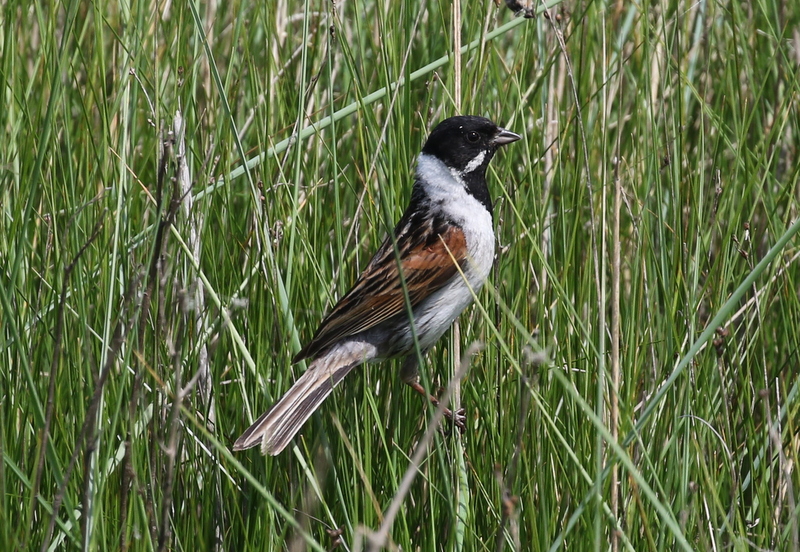 Reed Bunting – in front of the shelter at Arnold’s Marsh
Reed Bunting – in front of the shelter at Arnold’s Marsh
We had heard lots of gargling from the trees on our walk out, and seen several Little Egrets flying in and out. One dropped down onto the pools opposite the shelter. This one was in full breeding plumage, with bright pink and lilac bare skin at the base of its bill, and a mass of plumes, two long ones hanging down its nape, and lots of fine filoplumes over the back of its wings. Very smart, although it seemed to have a broken lower mandible.
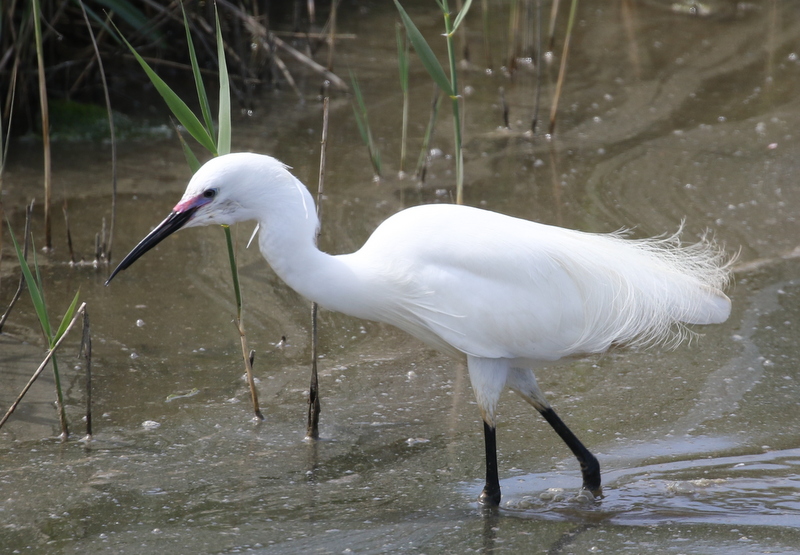 Little Egret – in full breeding attire
Little Egret – in full breeding attire
Back at the car park, we enjoyed a late lunch in the sunshine out on the picnic tables. A Common Whitethroat kept us company, singing from the very top of the hawthorn across the road.
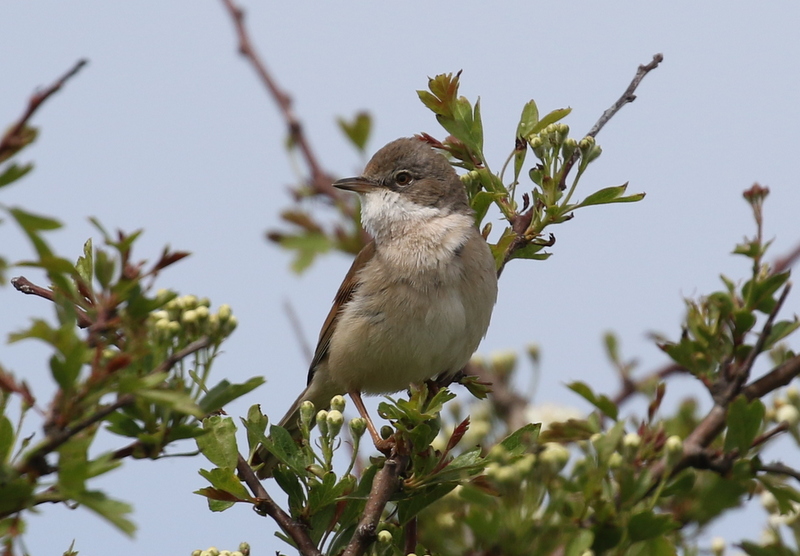 Common Whitethroat – singing from the top of a hawthorn
Common Whitethroat – singing from the top of a hawthorn
After lunch, we made our way back to Holkham. Lady Anne’s Drive was surprisingly not as busy as we had feared on such a lovely day – perhaps the weather forecast had put visitors off today – which meant there were plenty of places to park. As we walked west on the edge of the pines, two Spoonbills flew right overhead giving us a fantastic view of their spoon-shaped bills. There were a few insects out enjoying the sunshine, lots of Wall Brown butterflies and a couple of Hairy Dragonflies.
 Wall Brown – there have been lots on the wing in recent days
Wall Brown – there have been lots on the wing in recent days
The pines were rather quiet at first, which is to be expected in the middle of a warm afternoon. We eventually found a few Coal Tits in the trees and a couple of Goldcrests. Several Blackcaps and Chiffchaffs were singing from the bushes. Just before Joe Jordan Hide, we encountered a large flock of Long-tailed Tits and a Treecreeper was in with them, but hard to see in the tops of the trees.
From the hide, we could see a couple of Spoonbills in the trees. Three dropped down to the pool to bathe & preen. They were rather obscured behind the reedy edge at first but one eventually moved along to a more open spot where we could get a better look at it. We could see the yellow tip to its bill, the shaggy nuchal crest and the dirty mustard yellow wash across the breast, the features of an adult in breeding plumage.
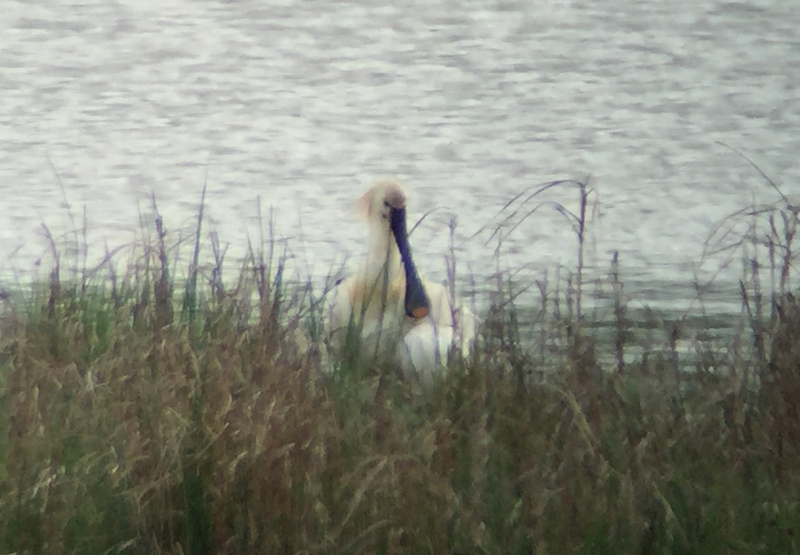 Spoonbill – an adult in breeding plumage on the pool
Spoonbill – an adult in breeding plumage on the pool
There were several Marsh Harriers flying in and out of the reeds and a Kestrel dust-bathing on a patch of bare ground. We were just scanning for the pair of Grey Partridges which are often out here when they were flushed by the cows and flew down into a ditch out of view. The cows crossed to the other side and when they came back, they very helpfully flushed them out again, straight towards hide. A Red-legged Partridge was flushed out too, but was chased off by the male Grey Partridge. The pair of Grey Partridges then came straight up to the grass right below the hide – cracking views!
 Grey Partridge – the male just below the hide
Grey Partridge – the male just below the hide
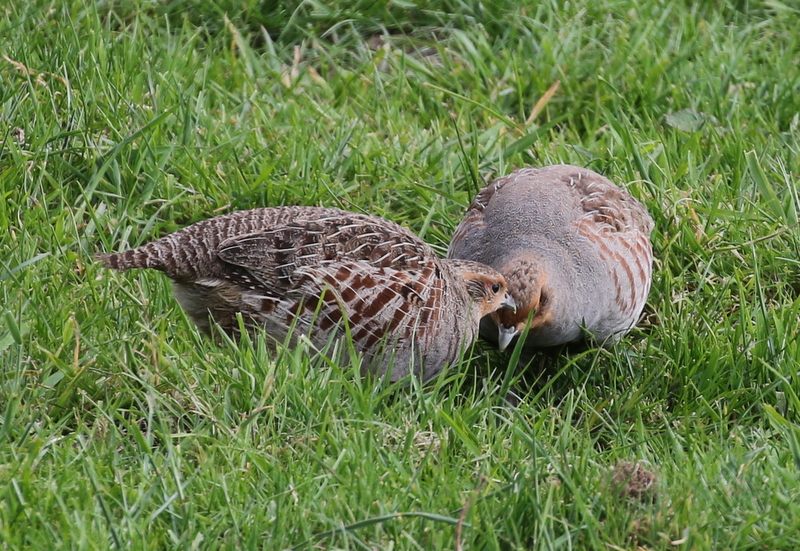 Grey Partridges – the pair feeding together
Grey Partridges – the pair feeding together
Time was getting on, so we made out way back to the car,stopping briefly to watch a family of Long-tailed Tits in the bushes, which had just been bathing on the edge of the grazing marsh. A Treecreeper with them gave us much better views.
We still had time for one last stop, so we popped in to the local gull colony. As we pulled up, a smart Common Gull was pulling at some rubbish by the road. A Spoonbill flew overhead. From the bank, a Great Crested Grebe was swimming in the harbour channel.
There were lots of gulls on views, mostly Black-headed Gulls but with a good number of Mediterranean Gulls in with them too. We got great views of several of the latter, looking very smart with their jet black hoods, heavier brighter red bills and pure white wingtips, compared to the Black-headed Gulls nearby. There were a handful of Common Gulls and a few Herring Gulls out here too.
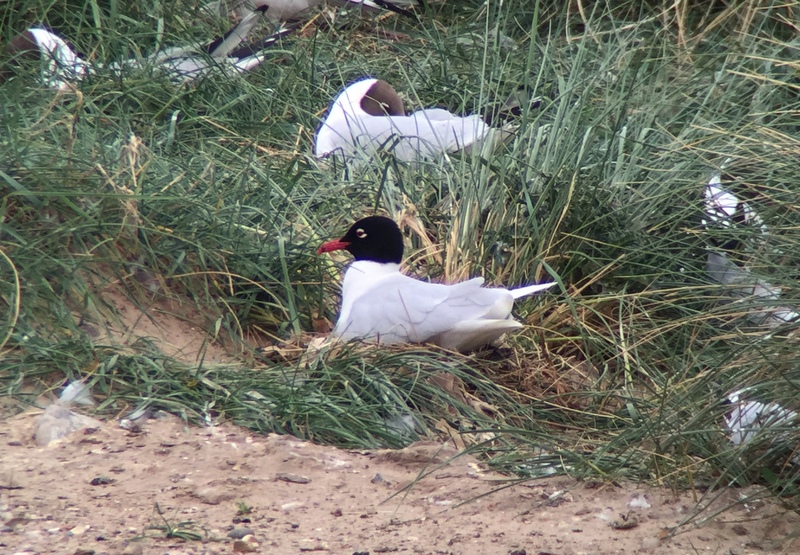 Mediterranean Gull – with smart black hood and white wingtips
Mediterranean Gull – with smart black hood and white wingtips
While we were admiring the gulls, we could hear terns calling too. A couple of Common Terns were loafing on the shingle. A single Sandwich Tern flew off calling. Two Little Terns flew round in formation, displaying to each other, with exaggerated wingbeats. A careful scan through the terns fishing over the channel beyond revealed a single Arctic Tern in among the more numerous Common Terns. Our second Arctic Tern of the day, we had a much better view of this one, much closer than our first as it flew up and down.
In the end we had to drag ourselves away. It was a lovely way to end the weekend, with such a great selection of gulls and terns, a hive of activity in front of us.
















